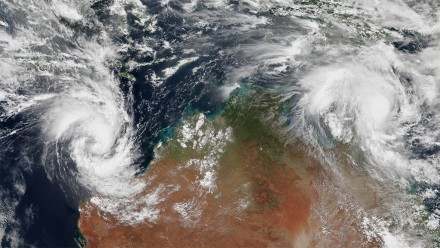Cyclogenesis Project
Background
Tropical cyclones are powerful storms that form over warm tropical waters. They can last for weeks and take unpredictable paths. These storms are very dangerous because they bring extremely strong winds, heavy rain leading to floods, and destructive storm surges. Between 1970 and 2019, the annual global cost of damage from cyclones was around US $28.5 billion, causing approximately 15,700 deaths each year.
Currently, efforts to reduce cyclone vulnerability focus on making buildings and planning more resilient, preparing for individual cyclones, and educating the public. However, these measures are insufficient, as cyclone-induced losses have doubled every 15 years over the last 30 years. The growth of coastal populations and cities is also exposing more people to cyclones. This has seen a rise in recent billion-dollar disasters like Debbie (2017), Gabrielle (2022), Fiona (2022), and Ian (2022).
The current mitigation approaches, focusing on reducing exposure and vulnerability, are not keeping up with climate change, with the risk of cyclones expected to increase in the future. In Australia, projected intensifying cyclones threaten communities along the east coast from Queensland to northern New South Wales, bringing higher risks of damaging winds and heavy rainfall. We urgently need new and transformative solutions to prevent deaths and destruction from cyclones by directly dealing with the cyclone threat itself. Cutting-edge research on intervening in cyclones from their early stages is essential. Among different methods like cloud seeding and ocean cooling, injecting aerosols into the atmosphere seems to be the most promising. Aerosols can change the way cyclone clouds form and behave, potentially reducing their impact.
In 2022, ANU initiated an international collaborative research effort with eminent experts in the field of Aerosol and Cloud Physics including Professor Daniel Rosenfeld from the Hebrew University of Jerusalem and Dr Jiwen Fan from the US Argonne National Laboratory.
Our collaborative initiative aims to quantify the interactions between aerosols and tropical cyclone evolution, towards a goal of understanding how to modify tropical cyclones effectively, utilising a modelling simulation framework.
The objectives of the project are as follows:
-
Advancing our fundamental understanding of aerosol-cloud interactions in cyclonic storms, including fully fledged tropical cyclones.
-
Advancing a simulation capability to represent these aerosol-cloud processes and their effects on storm dynamics, microstructure, and rainfall processes.
-
Quantifying the impact and effects of various processes involved in tropical cyclone formation and development, including the relative influence of the external environment, the role played by oceans, and the effect of aerosols (artificial or natural).
-
Better understanding of how these factors manipulate the energy cascade in tropical cyclones, and thence their destructive behaviour.
-
Assessing the viability of mitigating tropical cyclone risks by injecting aerosols to both guide and pave the way for further seeding experiments in the field.
Progress
The Cyclogenesis project started in 2022 with a review of the feasibility and governance of tropical cyclone intervention, published in Climate Risk Management (Miller et al., 2023). This identified that aerosols showed significant promise in reducing tropical cyclone intensity, motivating further research.
In 2023, we completed the first phase, which was to simulate the effects of adding aerosols during tropical cyclone initiation using a state-of-the-art atmosphere-ocean coupling model system. Promising results have been achieved showing that some specific aerosol perturbations led to significant reductions of the pre-tropical cyclone vortex’s energy.
In the next phase, we aim to test the model system with more advanced seeding strategies during later tropical cyclone development stages. Our goal is to gain further insight into how specific aerosol treatments affect the intensity, structure, and related rainfall and wind impacts of tropical cyclones when aerosol effects are intertwined with the strong dynamics of the mature tropical cyclone. The total impacts will be quantified, as a basis to identify the most effective strategies for minimizing cyclone intensity.
Benefit and impact
This project will potentially yield significant economic, environmental, and social benefits to Australia and other parts of the world that are prone to cyclones now and into the future as the climate warms. It will make a substantial contribution to the science of aerosol impacts on the genesis and development of cyclonic circulations. It will support innovative strategies for managing the increasing risks of tropical cyclones and call for global efforts to prepare for more extreme weather events fuelled by climate change.
Team
- Project Lead: Associate Professor Roslyn Prinsley, Head of Disaster Solutions, ANU Institute of Climate, Energy and Disaster Solutions (roslyn.prinsley@anu.edu.au)
- Research Lead: Dr Thao Linh Tran, Research Fellow, ANU Institute of Climate, Energy and Disaster Solutions, Research School of Earth Sciences (thaolinh.tran@anu.edu.au)
- Professor Daniel Rosenfeld, Institute of Earth Sciences, Hebrew University of Jerusalem
- Dr Jiwen Fan, Deputy Division Director, Environmental Science, US Argonne National Laboratory
- Dr Helen Cleugh, Honorary Professor, Institute for Climate, Energy and Disaster Solutions
- Professor Andy Hogg, Director of ACCESS-NRI, ANU
- Professor John Finnigan, CSIRO Oceans and Atmosphere, ANU Research School of Biology











